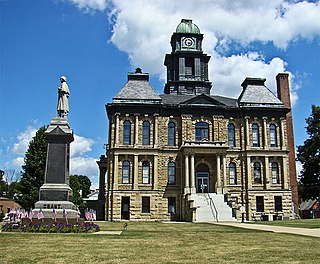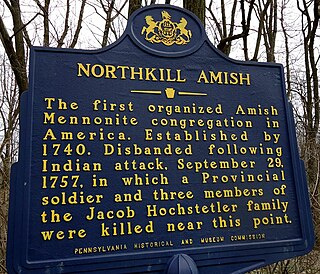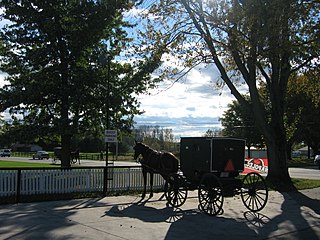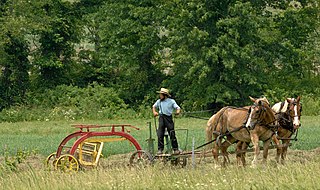Related Research Articles

The Mennonites are members of certain Christian groups belonging to the church communities of Anabaptist denominations named after Menno Simons (1496–1561) of Friesland. Through his writings, Simons articulated and formalized the teachings of earlier Swiss founders. The early teachings of the Mennonites were founded on the belief in both the mission and ministry of Jesus, which the original Anabaptist followers held to with great conviction despite persecution by the various Roman Catholic and Protestant states. An early set of Mennonite beliefs was codified in the Dordrecht Confession of Faith in 1632, but the various groups do not hold to a common confession or creed. Rather than fight, the majority of these followers survived by fleeing to neighboring states where ruling families were tolerant of their belief in believer's baptism. Over the years, Mennonites have become known as one of the historic peace churches because of their commitment to pacifism.

Lancaster County, sometimes nicknamed the Garden Spot of America or Pennsylvania Dutch Country, is a county located in the south central part of the Commonwealth of Pennsylvania. As of the 2010 census, the population was 519,445. Its county seat is Lancaster.

Lancaster is a city located in South Central Pennsylvania which serves as the seat of Pennsylvania's Lancaster County and one of the oldest inland towns in the United States. With a population of 59,322, it ranks eighth in population among Pennsylvania's cities. The Lancaster metropolitan area population is 507,766, making it the 101st largest metropolitan area in the U.S. and second largest in the South Central Pennsylvania area.

Holmes County is a county located in the U.S. state of Ohio. As of the 2010 census, the population was 42,366. Its county seat is Millersburg. The county was formed in 1824 from portions of Coshocton, Tuscarawas and Wayne counties and organized the following year. It was named after Andrew Holmes, an officer killed in the War of 1812.
The Pennsylvania Dutch (Pennsilfaanisch-Deitsche), also referred to as the Pennsylvania Germans, are a cultural group formed by early German-speaking immigrants to Pennsylvania and their descendants. The word Dutch refers to the German settlers, known endonymically as Deitsch or Deutsch ; it does not refer to people from the Netherlands. Most Pennsylvania Dutch emigrated in the 17th and 18th centuries to the Americas from within the Holy Roman Empire, which included areas that were later to become Germany, Switzerland and Austria. Over time, the various dialects spoken by these immigrants fused into a unique dialect of German known as Pennsylvania German or Pennsylvania Dutch.

Pennsylvania German, often called Pennsylvania Dutch, is a variety of West Central German spoken by the Old Order Amish, Old Order Mennonites and other descendants of German immigrants in the United States and Canada, closely related to the Palatine dialects. There are possibly more than 300,000 native speakers in the United States and Canada. In Pennsylvania 29.9% of the population currently claim German ancestry.

The Nebraska Amish, also called Old Schoolers, are a relatively small affiliation of the Amish. They are the most conservative subgroup of Amish, indicated not only by their use of technology but also by their peculiar style of dress. They emerged in 1881 as a conservative split from the Byler Amish who themselves emerged as the first conservative splinter group from the Amish mainstream in 1849.
The New Order Amish are a subgroup of Amish that split away from the Old Order Amish in the 1960s for a variety of reasons, which included a desire for "clean" youth courting standards, meaning they do not condone the practice of bundling, or non-sexually lying in bed together, during courtship. Tobacco and alcohol are also not allowed. They also wished to incorporate more evangelical elements into the church, including Sunday school and mission work. Some scholars see the group best characterized as a subgroup of Old Order Amish, despite the name.
Weavertown Amish Mennonite Church is a Beachy Amish Mennonite congregation located in the village of Weavertown, between the somewhat larger villages of Bird-in-Hand and Intercourse in Lancaster County, Pennsylvania, United States.

The Northkill Amish Settlement was established in 1740 in Berks County, Pennsylvania. As the first identifiable Amish community in the new world, it was the foundation of Amish settlement in the Americas. By the 1780s it had become the largest Amish settlement, but declined as families moved elsewhere.

The Beachy Amish Mennonites are formally a subgroup of Amish but they are much less traditional than other Amish. Even though they have retained the name "Amish" they are quite different from the common idea of Amish: they do not use horse and buggy for transportation, with a few exceptions they do not speak Pennsylvania German anymore, nor do they have restrictions on technology except for radio and television. In the years 1946 to 1977 a majority was transformed into an evangelical revivalist denomination. The traditionalists who wanted to preserve the old Beachy Amish ways then withdrew and formed their own congregations. Today they are known as Midwest Beachy Amish Mennonites or Old Beachy Amish.

The Groffdale Conference Mennonite Church, also called Wenger Mennonite, is the largest Old Order Mennonite group to use horse-drawn carriages for transportation. Along with the automobile, they reject many modern conveniences, while allowing electricity in their homes and steel-wheeled tractors to till the fields. Initially concentrated in eastern Lancaster County, Pennsylvania, their 10,000 members resided in eight other states as of 2008/9.

The Amish are a group of traditionalist Christian church fellowships with Swiss German Anabaptist origins. They are closely related to, but a distinct branch off from, Mennonite churches. The Amish are known for simple living, plain dress, Christian pacifism, and are slower to adopt many conveniences of modern technology, with a view to not interrupting family time, nor replacing face-to-face conversations whenever possible.

Northkill Creek is a stream primarily located in Berks County, Pennsylvania. It feeds into Tulpehocken Creek and covers part of the Schuylkill River and Delaware River watersheds. Northkill Creek and its tributaries are high quality trout streams.

Conservative Mennonites include numerous groups that identify with the more conservative or traditional element among Mennonite or Anabaptist groups but who are not Old Order groups. The majority of Conservative Mennonite churches historically have an Amish and not a Mennonite background.
Amish believe large families are a blessing from God. Amish rules allow marrying only between members of the Amish Church. The elderly do not go to a retirement facility; they remain at home.
Subgroups of Amish developed over the years, as Amish churches have divided many times over doctrinal disputes. The 'Old Order' Amish, a conservative faction that withdrew from fellowship with the wider body of Amish in the 1860s, are those that have most emphasized traditional practices and beliefs. There are many different subgroups of Amish with most belonging, in ascending order of conservatism, to the Beachy Amish, New Order, Old Order, or Swartzentruber Amish groups.

The Renno Amish, also called Peachy Amish or "black toppers" are a subgroup of Amish that was formed in 1863 in Mifflin County, Pennsylvania. They are the moderately conservative Old Order Amish group in Kishacoquillas Valley, locally called Big Valley, but still relatively conservative compared with the Amish of other regions.
The Swiss Amish are a subgroup of the Amish that emigrated to the United States mostly in the middle of the 19th century directly from Switzerland and Alsace, after the 18th-century emigration of most Amish via the Palatinate. They do not speak Pennsylvania German, but either a form of Bernese German or a Low Alemannic Alsatian dialect. Their main settlements are in Adams County, Indiana and in Allen County, Indiana. They form two distinct Amish affiliations.

The Amish in Maryland maintain a small but well-established population. There have been four Amish communities in the history of Maryland, three of which currently exist. The three Amish communities of Maryland are located in Western Maryland, Southern Maryland, and on the Eastern Shore. Historically, an Amish community also existed in rural Baltimore County, but had disappeared by the 1950s. The Amish communities of Maryland are all inhabited by the descendants of Amish migrants from Pennsylvania. In 2018, Maryland had an Amish population of around 1,575 people.
References
- ↑ Steven M. Nolt: A History of the Amish, Intercourse, Pennsylvania 1992, p. 86.
- ↑ Steven Hartman Keiser: Pennsylvania German in the American Midwest, Durham, NC 2012.
- ↑ Somerset County at amishamerica.com.